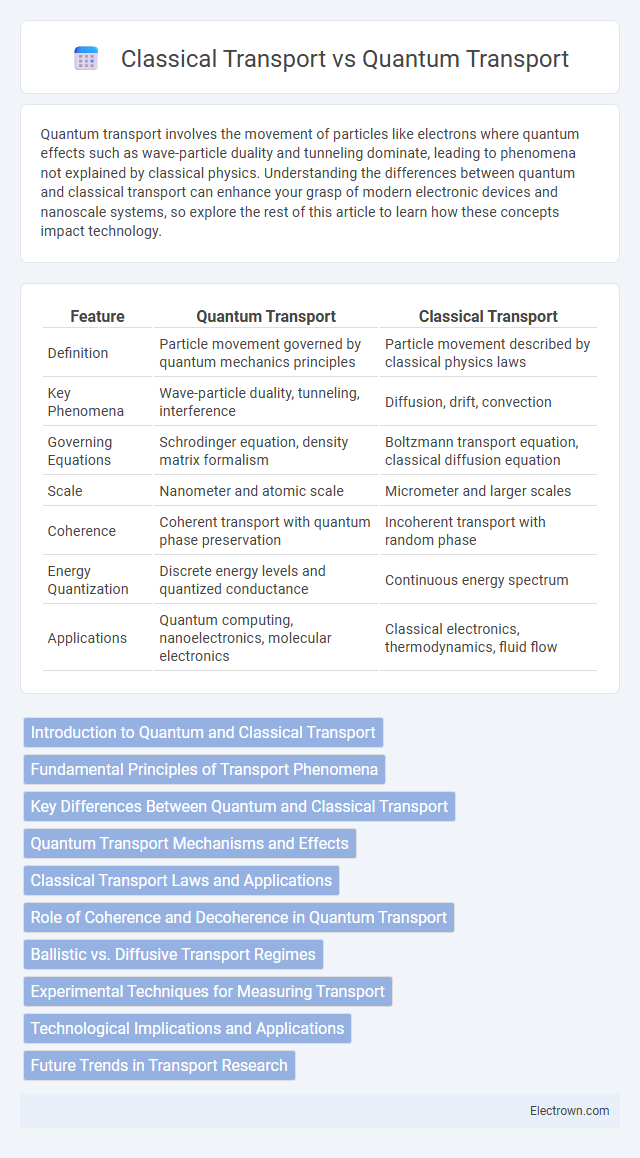Quantum transport involves the movement of particles like electrons where quantum effects such as wave-particle duality and tunneling dominate, leading to phenomena not explained by classical physics. Understanding the differences between quantum and classical transport can enhance your grasp of modern electronic devices and nanoscale systems, so explore the rest of this article to learn how these concepts impact technology.
Table of Comparison
| Feature | Quantum Transport | Classical Transport |
|---|---|---|
| Definition | Particle movement governed by quantum mechanics principles | Particle movement described by classical physics laws |
| Key Phenomena | Wave-particle duality, tunneling, interference | Diffusion, drift, convection |
| Governing Equations | Schrodinger equation, density matrix formalism | Boltzmann transport equation, classical diffusion equation |
| Scale | Nanometer and atomic scale | Micrometer and larger scales |
| Coherence | Coherent transport with quantum phase preservation | Incoherent transport with random phase |
| Energy Quantization | Discrete energy levels and quantized conductance | Continuous energy spectrum |
| Applications | Quantum computing, nanoelectronics, molecular electronics | Classical electronics, thermodynamics, fluid flow |
Introduction to Quantum and Classical Transport
Quantum transport describes the movement of particles, such as electrons, through materials where quantum effects like wave-particle duality, tunneling, and coherence dominate. Classical transport, based on classical physics principles, explains charge and heat flow using concepts like drift and diffusion without accounting for quantum coherence or interference. Understanding the fundamental differences between quantum and classical transport is essential for designing nanoscale electronic devices and exploring novel materials with quantum behaviors.
Fundamental Principles of Transport Phenomena
Quantum transport describes particle flow based on wave-particle duality and quantum coherence, governed by the Schrodinger equation and quantum tunneling effects. Classical transport relies on macroscopic laws like Fourier's, Fick's, and Ohm's laws, assuming particles follow deterministic paths without quantum interference. Understanding these fundamental differences helps you accurately model charge, heat, or mass transfer in nanoscale versus macroscopic systems.
Key Differences Between Quantum and Classical Transport
Quantum transport involves electron or particle movement governed by wave-like properties, coherence, and quantum interference effects, leading to phenomena like tunneling and quantized conductance. Classical transport relies on particle-like behavior, described by macroscopic laws such as Ohm's law and diffusion equations, with collisions causing stochastic scattering and energy dissipation. Your understanding of nanoscale devices benefits from distinguishing quantum transport's coherence and superposition principles from classical transport's probabilistic and incoherent motion.
Quantum Transport Mechanisms and Effects
Quantum transport mechanisms involve wave-like electron behavior, enabling phenomena such as tunneling, interference, and quantized conductance, which are absent in classical transport. Unlike classical transport based on particle diffusion and scattering, quantum transport relies on coherent electron wavefunctions and phase relationships that significantly affect conductivity at the nanoscale. Understanding these quantum effects can enhance Your control of electronic devices in quantum computing and nanoelectronics.
Classical Transport Laws and Applications
Classical transport laws, including Fourier's law of heat conduction, Fick's law of diffusion, and Ohm's law of electrical conduction, describe how heat, particles, and charge move within materials based on macroscopic properties like temperature gradients, concentration differences, and electric fields. These laws are widely applied in engineering fields such as thermal management, chemical diffusion processes, and electrical circuit design, providing reliable predictions for everyday systems. Understanding classical transport helps ensure your designs effectively manage energy and material flow in conventional environments where quantum effects are negligible.
Role of Coherence and Decoherence in Quantum Transport
Quantum transport differs fundamentally from classical transport by relying on the principles of coherence and superposition, enabling particles to traverse multiple paths simultaneously and exhibit wave-like interference effects. Decoherence disrupts this delicate quantum coherence by entangling the system with its environment, causing a transition to classical behavior and loss of quantum advantages in transport efficiency. Understanding the balance between coherence and decoherence is crucial for optimizing your quantum devices, as maintaining coherence can significantly enhance transport properties beyond classical limits.
Ballistic vs. Diffusive Transport Regimes
Ballistic transport occurs when charge carriers such as electrons move through a material without scattering, preserving their momentum over nanoscale distances, which is critical in quantum transport systems. In contrast, diffusive transport dominates classical regimes where carriers frequently scatter due to impurities or phonons, causing random, resistive motion. Your understanding of nanoscale device performance hinges on recognizing how ballistic transport enhances speed and efficiency compared to the dissipative nature of diffusive transport in classical materials.
Experimental Techniques for Measuring Transport
Experimental techniques for measuring quantum transport often utilize low-temperature setups combined with precision scanning tunneling microscopy (STM) and quantum point contacts to observe electron coherence and tunneling effects. In contrast, classical transport measurements typically employ electrical resistance or Hall effect measurements at room temperature to analyze bulk conductive properties. Understanding these distinct approaches helps you accurately characterize material behavior in nanoscale versus macroscopic regimes.
Technological Implications and Applications
Quantum transport enables ultra-fast and low-power electronic devices by leveraging wave-like electron behavior and quantum coherence, crucial for advancements in quantum computing and nanoscale sensors. Classical transport, relying on particle-like electron flow and scattering, supports conventional semiconductor technologies but faces limitations in miniaturization and energy efficiency. Quantum transport's enhanced control at atomic scales drives innovations in spintronics, quantum dots, and next-generation transistors, surpassing classical transport capabilities in emerging nanoelectronics.
Future Trends in Transport Research
Quantum transport research is rapidly advancing with breakthroughs in topological materials and quantum coherence, promising ultra-efficient nanoscale devices. Classical transport continues to evolve through machine learning integration for optimizing traffic flow and energy usage in smart cities. Your engagement with emerging hybrid systems combining quantum and classical strategies will redefine future transport solutions.
Quantum Transport vs Classical Transport Infographic

 electrown.com
electrown.com